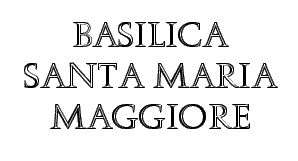
| The Basilica Santa Maria Maggiore is one of the four Papal
Basilicas of Rome and the largest church dedicated to Mary. Hence
the name Maria Maggiore (Mary Major). The first Christian church
on this site was built by Pope Liberius in 352 AD. According to
tradition, Liberius had a dream on the night of August 4, 352 in which
the Virgin Mary appeared to him and instructed him to build a church in
the snow. There's not usually much snowfall in Rome in August
..... or any other time. As he was meditating over this the
following morning, one of his stewards came in and reported that it had
snowed overnight on the Esquiline Hill. Liberius went there and
walked off the boundaries of the church in the snow. From this, it
got its first name Santa Maria della Neve (St. Mary of the Snow).
The original building was substantially restored, renovated, and added
to in the 18th century to achieve its present appearance.
The basilica is the final resting place of St. Jerome, six popes, and an assortment of other dignitaries, including a member of the Bonaparte family. |
|
|
|
The facade of the basilica . The campanile is the tallest in Rome at 240 feet and was added in the 11th century. The column in the piazza was erected using a recycled column from the Basilica of Maxentius in the Roman Forum in 1613. The base, top statue, and artwork were added. It was erected in thanksgiving for the end of the bubonic plague. |
|
|
|
This narthex was added to the facade in the 18th century. The statue at the end is of Philip IV of Spain, a benefactor of the project. |
|
|
|
The vaulted ceiling of the narthex. |
|
|
|
A papal coat of arms on the floor of the narthex before the main entry. I've yet to track down which Pope. |
|
|
|
One of the doorways showing a dedication by Pope Pius XII in 1949. |
|
|
|
The Holy Door. This is a new one dedicated by Pope John Paul II in 2001. |
|
|
|
The ceiling of the nave is coated with a thin layer of gold, said to have been donated by Spain, whose armies took it from the Incas in their conquest of the Americas. |
|
|
|
The baldaccino and the main altar. The triumphal arch over the apse as well as the apse is covered with mosaics. |
|
|
|
The main (papal) altar with the apse in the background. |
|
|
|
The most well-known of the relics housed in Maria Maggiore: The Sacra Culla (Holy Crib). All that remains of the relic is 3 small ancient pieces of board. According to tradition, these boards which were brought from the church in Jerusalem by the Crusaders after their final loss to the Muslim invaders were pieces of the infant crib in which the baby Jesus slept. We're not talking manger here, but a regular crib used in that period in Galilee. It would have consisted of crossed boards on each end with a strut running between the two sets of crossed boards to support an open terra cotta vessel. Over the centuries, when Rome was sacked by first one invader and then another, the caretakers of Maria Maggiore have always hidden away the boards. The invaders take the gold and crystal reliquary and go happily on their way. This particular reliquary was made by Valadier in the 18th century. |
|
|
|
The cosmatesque flooring is one of the most attractive in Rome. |
|
|
|
The baptistery built at the direction of Pope Leo XII in the early 19th century. |
|
|
|
The Borghese Chapel is decorated in rare beauty. Mass was underway with no photography permitted when we were there. |
|
|
|
The stained window over the front doorway. |